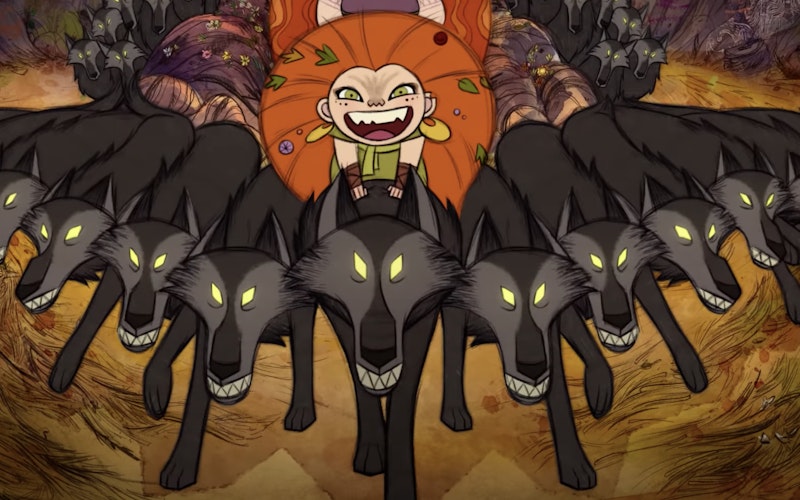
Movies
The Wild Witness of Wolfwalkers
A stern man strides into a great medieval hall, consternation creasing his face. Weary and worried, he closes his eyes and begins to pray. His prayer begins with a question familiar to every Christian, a question that must be asked by anyone who wants to serve God: "Lord, what must I do?"
But this query—posed in Wolfwalkers, an animated film now available on Apple TV Plus—is not being asked by just anyone. It comes from the Lord Protector (voiced by Simon McBurney), a fictionalized version of English leader Oliver Cromwell. Designed with thick black lines and sharp angles, the Lord Protector’s features remain severe, even in prayer. “This wild land must be civilized,” he intones before looking upward to finish his prayer, his face given a hellish glow by the fire of a nearby torch, “This is your will.”
Set in 1650 Ireland, Wolfwalkers pulls from Irish folklore to tell the story of Robyn Goodfellowe (Honor Kneafsey), an English girl brought to the village of Kilkenny with her father Bill (Sean Bean), a hunter charged with ridding the neighboring forest of wolves. Hoping to impress her father, Robyn sneaks into the woods to do some hunting of her own. She encounters a green-eyed wolf whose playful snaps she returns with punches and kicks, resulting in Robyn getting bitten. The wolf, Robyn discovers, is in fact a girl named Mebh Óg MacTíre (Eva Whittaker). Mebh and her mother Moll (Maria Doyle Kennedy) are wolfwalkers—humans who speak to wolves, magically heal wounds, and can become wolves themselves. Thanks to the bite from Mebh, Robyn has become a wolfwalker too.
Directors Tomm Moore and Ross Stewart, working from a screenplay by Will Collins and a story they conceived with Jericca Cleland, use detailed hand-drawn animation to contrast the rigid drabness of the Lord Protector’s rule to the untamed beauty of the woods. Whereas soldiers in the Lord Protector’s army stand in rigid attention and women in the scullery work with piston-like precision (all composed with thick lines that reduce the people to indistinct shapes), the woodland creatures are rendered with light, expressive linework and colors that blend into one another. They imagine Mebh as energy personified, with giant green eyes and smiling sharp teeth protruding from an unkempt ball of red hair. At first, Robyn is drawn with the same severe angles and thick lines as the other English characters, but she gets a more dynamic design when she becomes a wolfwalker.
That technique defines a scene in which Robyn and Mebh frolic together as wolves. Trees curve around the pair and flit past them like rolling waves as they race along the trails. Greens and blues and reds and pinks bleed seamlessly together. When the camera takes the POV of Robyn in wolf form, we see trails of yellow and green flowing from every living creature, illustrating their connection to the woods and to each other.
Even as it captures the charms of the wilderness, Wolfwalkers never ignores its dangers. The movie opens with a scene of a wolf pack attacking a Kilkenny woodcutter—the animation highlighting the animals’ flinty eyes and razor teeth. But the film insists that the danger of the woods is inseparable from its beauty. The natural world of Wolfwalkers is a place of power.
The detailed animation contrasts the rigid drabness of the Lord Protector’s rule to the untamed beauty of the woods.
Although the Lord Protector dismisses the wolfwalkers’ love of nature as pagan foolishness, Potawatomi author Kaitlin B. Curtice urges us to listen to the stories being told by the earth and its creatures. “We listen to water as it runs in the creek, and we listen when God whispers through tree branches on the wind,” writes Curtice. “And if we desire to be people who love one another well, we have to begin with our creature kin, with the ones who crawl and slither and swim and fly, the ones who are different from us but who hold deep knowledge and incredible stories about this earth we live in.”
The Bible finds similar value in listening to the stories of God’s creation. Psalmists see God’s glory in the “sun and moon,” the “great sea creatures and ocean depths,” and the “fruit trees and all cedars.” Job tells his accusers to “speak to the earth” and learn about God’s goodness. Even Paul insists that God’s “eternal power and divine nature” is made clear by creation. Throughout scripture, the wilderness serves as witness to the power and goodness of God.
In Wolfwalkers, Robyn and Mebh see the wonders offered by nature and they revel in it. They take joy in both the fruit dangling from branches and the thorns protruding from briars. In the games they play, in the healing they perform, and even the freedom they relish, viewers see echoes of a wild God who created humans to live with all living things, to learn from nature even as we care for and take pleasure in it.
For all his piety, the Lord Protector cannot see God’s goodness in the forest. He sees the woods only as land to be colonized, conquered, and tamed. As his name suggests, the Lord Protector prioritizes safety over all else, insisting that only control can protect the people. He declares that his subjects have “nothing to fear if they trust God’s will,” but he then tells the people of the danger posed by anything that he cannot control, whether it be Irish men and women resisting English rule or the wolves in the forest.
Although Moore and Stewart position the Lord Protector as a mere villain, he is to Christian viewers a tragic figure. The Lord Protector is so certain his will is God’s will that he misses what God really wants for him: to give up fear and pretensions to control and see the wild wonder of the world God created.
Topics: Movies